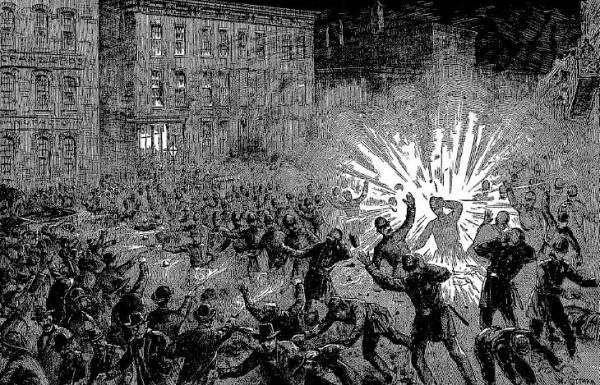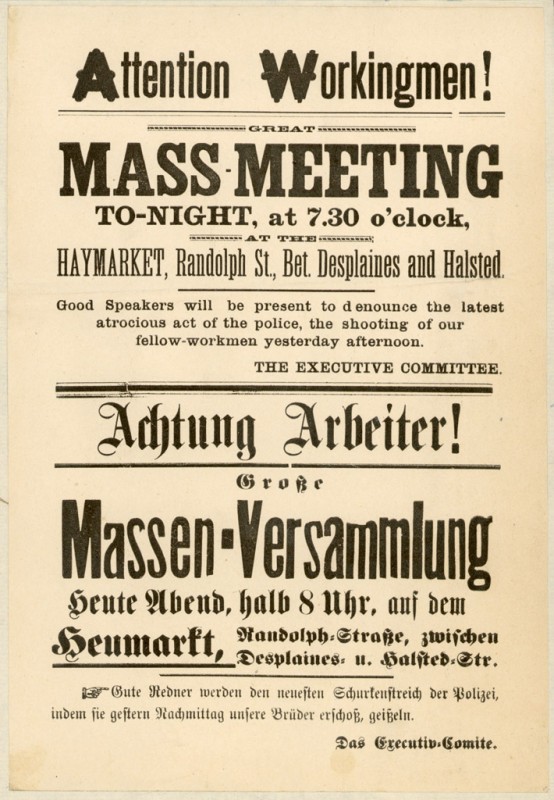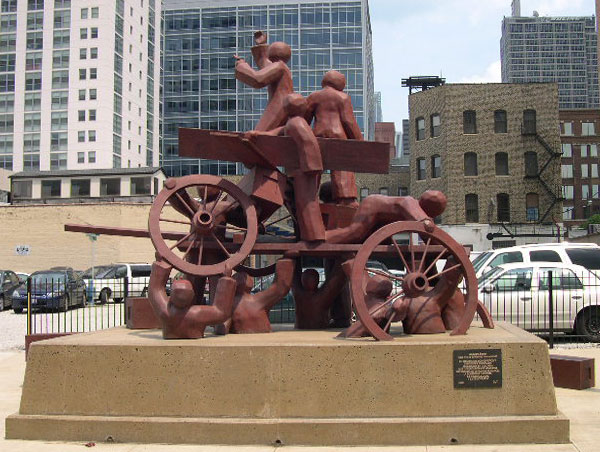On the evening of the first Tuesday in May 1886, 180 officers of the Chicago police department marched into a crowd double that size made up of anarchists, striking laborers, and the merely curious. The crowd had gathered earlier that evening in an area just a block north and east of a large central market; they were there to protest the firing by police the day before into a body of striking iron molders at the McCormick Reaper Works. The first of the month had marked the commencement of a nationwide strike for the eight-hour workday (an industrial laborer of the era typically worked anywhere from twelve to sixteen hours six days a week), and on that day alone some 50,000 workers from a range of trades had walked off their jobs in Chicago. Many of them were immigrants as were many of the police officers who had marched a block north from their station to break up the protest. A light rain had started to fall, and the speaker on the improvised stand, a hay wagon, was just wrapping up. The police carried pistols and truncheons. As the head of the march, William Ward, ordered the speaker on the wagon, Samuel Fielden, to break up the meeting, someone in the crowd threw a bomb into the middle of the columns of police. The explosion killed one officer instantly, and seven more later died from wounds sustained from shrapnel or gunshots. The bombing was the first significant act of domestic terrorism on American soil and impacted the history of labor, Chicago, the country, even the world. The incident was called a “riot,” a “massacre,” and, later, the more innocuous sounding “affair,” but was always attached to another word, the name of the site, Haymarket.
The aftermath of the bombing resulted in a tragedy of different kind. Unable to identify the bomber, the state put the three men who spoke at the protest, some others involved in its planning, and a few more radical members of the labor movement on trial. They were convicted for their beliefs more than for any involvement with the violent act. One went straight to the penitentiary; two more who were sentenced to die received commuted life sentences from the governor of Illinois; yet another committed suicide in prison; and the remaining four went to the gallows on November 11, 1887. While the incident at Haymarket set back the push for the eight-hour day, the fate of the eight men inspired the labor movement as a whole, leading to May 1 being designated as an international Labor Day. Out of the tumult of the 1880s arose the nascent unions, and along with them better wages, increased worker safety, and pensions—in short many things now considered rights by the American people but always in danger of disappearing. More than 125 years later the incident at Haymarket continues to resonate as economic inequality broadens and work across industries and trades becomes more precarious. It’s a story worth knowing, not only to help make sense of the present but also to speculate on possible futures.
To learn more about the Haymarket story, visit the memorial sculpture, designed by Mary Brogger, at the corner of Randolph and Desplaines, the site of the meeting and the subsequent violence. Each May 1 at a public rally the Illinois Labor History Society adds a plaque from an international labor organization to the sculpture’s base. The Society also maintains the memorial to the eight labor leaders in Waldheim Cemetery, west of Chicago, and offers walking and bus tours that tell the story.
If you happen to be in Chicago in the spring of 2014, also be certain to check out the Jane Addams Hull House Museum, which currently has an exhibit on the eight-hour workday movement.




There are no voices yet... Post-script us a message below, won't you?